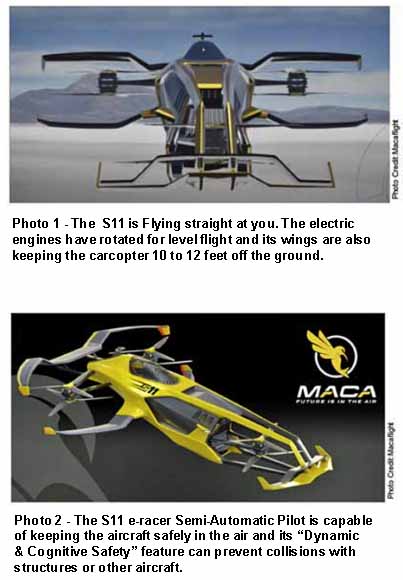


If you never heard of the Jetsons, they were a popular animated 1962 sitcom family with a flying car. You can visit them online at https://youtu.be/uPnZpENoypo.
Open fly zones in the sky for flying cars have always seemed like a future technology that would be here by now. At this point in time a number of flying cars have been created but I expect that none of your neighbors has one parked in their driveway.
A new spin off company by Airbus just might have created a way to get its Carcopter off the ground and into the hearts and minds of people. The Maca Flight S11 concept vehicle, they call a carcopter, is actually a vertical takeoff and landing electric (eVTOL) multi-rotor air mobility vehicle. See photo 1 & 2. The big hurdle that eVTOL manufacturers have is getting their aircraft safety certified by the USA Federal Aviation Administration (FAA) and the European Aviation Safety Agency (EASA).
To generate lots of buzz and show how safe this type of transportation vehicle could be, Meca and some other eVTOL aircraft manufacturers are introducing their aircraft to the world as a flying formula 1 all electric E-Racer. The race track that the eVTOLs will fly around could be the perfect place to acquire all the flight testing and data that the FAA and EASA require for these aircraft to be fully certified.
The Maca Flight 11 is electrically powered by a hydrogen fuel cell. Its top speed is 155 mph and it can fly this fast maintaining a height of just 10 to 12 feet off the ground. Its Semi-Automatic Pilot is capable of keeping the aircraft safely in the air and its “Dynamic & Cognitive Safety” feature can prevent collisions with structures or other aircraft. The S11’s first flight was a few months ago and Meca hopes to have certification by the end of 2023. For a better sense of what this multi-rotor eVTOL looks like go to. https://youtu.be/y5clByVXY2M.
Not only is Airbus the company that spun off Maca, it is also the founding partner of Air Race E. Airbus became an official founder of Air Race E to “create a mainstream platform in which innovation in electric propulsion can be developed, nurtured and accelerated rapidly”. Air Race E currently races winged fully electric airplanes. They are now developing the rules for eVTOL races that could begin this year or next year. These races will probably have 8 flying eVTOLs traveling at extremely high speeds just a few feet off the ground around an oval circuit that looks like a Formula 1 racetrack. To quote the Air Race E organizers, the “race format and its rules will be somewhat different than the airplane classes and will be revealed soon”.
A completely different kind of airplane race is about to get off the ground. The National Aeronautic Association (NAA) is a non-profit aviation organization that was founded in 1905 and it is “dedicated to the advancement of the art, sport, and science of aviation in the United States”. May 22-25, 2023 the NAA will be holding a 1,000-nautical-mile, cross-country air race for all electric winged and eVTOL aircraft. This race will be limited to 25 aircraft and it will start in Omaha Nebraska and end in Kitty Hawk North Carolina. The winner of this race will receive a Pulitzer Trophy. The airplanes in this race will only fly during the day (Visual Flight Rules) and the winner of the race will be the aircraft with the fastest speed. Each team’s speed will be calculated by totaling the sum of their multiple flight times. So the time that each all electric powered aircraft spends on the ground at night or maintenance will be excluded. The NAA indicates the “cross-country format was selected to emphasize electric aircraft range, reliability, and speed”.
Taking it a Step Further
The perfect hands on experience that parallels this column would be to have your students build and race aircraft of their own designs. Elementary school activities could be limited to paper airplanes and older students can build much more sophisticated aircraft to race.
